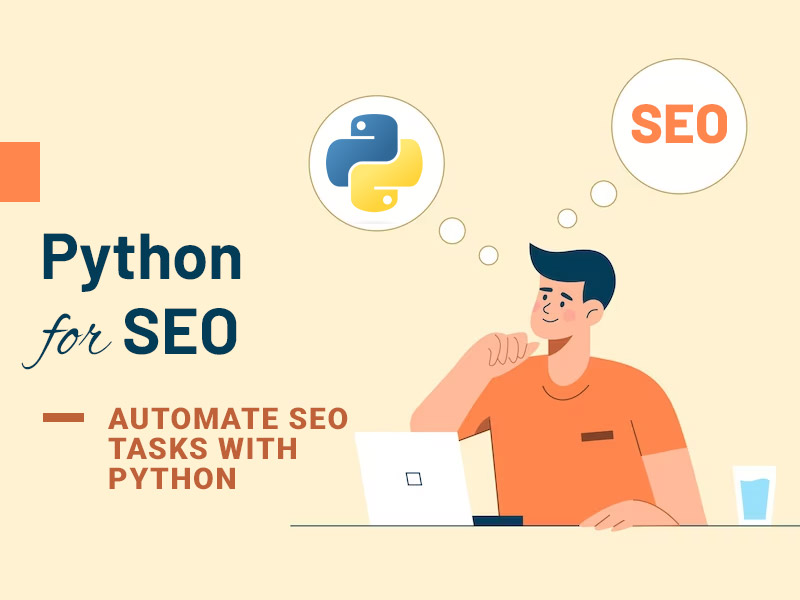In the 21st century, we live in a technology-driven world. It impacts every aspect of our lives. Technology and SEO together help us to automate those tasks, which would otherwise be impossible or take several months, weeks, and days. And it impacts our life in many ways. It is the reason why the ace SEO professionals are opting in for Python for SEO for automation tools and procedures for adding speed to the mundane tasks in Python.
Understanding Python
Simply put, Python is an object-driven, open-source programming language! It’s easy-to-learn and simple syntax helps in readability, which minimizes the program maintenance cost. It gets used for crawl/search data analysis, natural language processing as well as SEO tool automation. To know more about this, you can visit https://www.ethanetechnologies.com.
How to Automate SEO Tasks with Python
Expert SEO professionals and agencies can guide you on the SEO tasks that can get automated with Python. The important ones are discussed below:
1. Web optimization investigation of the webpage for basic issues
Search engine optimization analyzer API breaks down the structure of a site, slithers the site, include words in the body of the site and cautions of any broad SEO related issues.
Some significant highlights are:
- Word check
- Page Title
- Meta Description
- Catchphrases on-page
- Admonitions
- Missing
- Title
- Portrayal
- Picture alt-content
2. Competitive analyses
It’s hard to save your eyes on rivals constantly for their updates and dispatches. Python makes your dull undertakings computerized.
For instance, use it to bring the subtleties of your rival’s administrations and items to screen.
3. Content curation and suggestion
Internet gushing destinations like Netflix and Amazon Prime all utilize a specific substance proposal motor. The greater part of these calculations is created in Python.
Since it has colossal APIs and various libraries, it bolsters the best substance curation and suggestions. Python comprehends the significance of the pursuit string and shows the most ideal alternatives.
4. Analytics
You have most likely been utilizing an investigation apparatus to follow crowd conduct and commitment. Google’s website admin device utilizes Python contents to track and bring the information into different organizations.
You can utilize these open-source libraries to move the information straight into archive documents.
5. Implementation
Usually, the SEO consultants and agencies have a common frustration! That is, their clients fail to execute the recommendations they suggest, even when it’s aimed at enhancing live performance. Different clients have different reasons for this. However, the most important reason for this is that they lack the necessary resources and expertise to execute the same. And it is true when there’s a challenging content management format.
Fortunately, today you can opt-in for solutions such as RankSense. It enables the users to execute close to three essential recommendations, such as descriptions, robots.txt, and tags weekly or daily in the CDN (Content Delivery Network). Today, you can implement the SEO recommendations within a few days than months.
Simultaneously, it is necessary to realize that developers are humans! Hence, they can make errors that impact SEO negatively. It can include blocking a website, because it directed a brand-new staging website to production, keeping the robots.txt file unchanged. RankSense notifies the users about similar errors and resolves the same immediately. That way, it doesn’t affect organic traffic negatively.
6. Intent categorization
Intent categorization gets influenced by visibility benchmarking. It is a tedious process that gets done manually. For a big website that has millions and thousands of keywords, the categorization keywords by the intent (Do, Think, See) can result in trouble. Today, SEO experts and professionals can attempt automated intent classification through deep learning. And this process depends on the new age neural networks. Python is one of the standard languages that gets used because of its vast library, as well as the rapid adoption in the academic community.
7. The process of visibility benchmarking
The method of visibility benchmarking helps to review a website and its instant profile against the competitors. It also identifies the gaps existing in the content coverage and popular keywords. It detects those situations where your competitors have more visibility than your website. You can extract data through SEMrush and various other data sources. If you wish to do this, you can add data to Excel and arrange the same according to the non-branded and branded keywords and in multiple visibility zones.
It is a challenging process if there are several non-branded keywords, competitors, and business lines to deal with. Also, you need to check if you have several subcategories and categories. When you use the Python scripts, you can easily automate the process as well as evaluate the cross-site traffic using overlapping keywords. It helps to capture the untapped audience as well as locate the content gaps. The process is way quicker and can get completed within a few hours.
8. Manage the XML Sitemaps
The XML sitemaps can get defined as the real maps on a website. It enables Google to know more concerning the crucial pages and those pages that are crawl worthy. Is your website a dynamic one? Does it have millions or thousands of web pages? If yes, then it might be complex to check the paged that gets indexed. It is also true when the URLs are present in substantial XML files.
It could be that you have essential pages on the website, which should get indexed and crawled. For instance, the best sellers on an eCommerce website or any famous destinations on a popular travel website. When you blend all the essential web pages with other less crucial ones, in the XML sitemaps, you possibly can’t know the moment when the pages are undergoing an indexing and crawling issue.
When you make use of the Python scripts, you can simply develop XML sitemaps. And it comprises of the webpages when you want to focus intently on the server and submits the Google Search Console.
Related: HTML Sitemap vs XML Sitemap
9. A deep SEO analysis
Most of us love the SEO tools, which offer a fast review on the page to check for SEO problems. The tools are as follows:
- Does the web page include correctly structured data?
- Does the page comprise of a witty title tag? Sometimes, people need to delve deeply into a state to know their personal preferences.
- Check whether the meta description is compelling and missing to derive a click?
- The number of words the web page comprises of?
- The most common terms and phrases that get used in the webpage?
Here you can count on the Python SEO analyzer that can easily recognize the issues on every page. It helps you to fix and also prioritize to maximize live performance.
The conclusion
Simply put, automation helps to support SEO professionals by saving excess time. Since its practical, others can focus on business development ideas and also enhance the client’s performance. Python happens to be one of the best programming languages that can automate annoying songs. That is not all. Even Google has become more advanced and sophisticated as a whole. Hence, it can automate so many memories. Therefore, it is necessary for this. Also, as you get acquainted with the SEO process and also learn the. If you have explored Python and Python for SEO, you better focus on emphasizing using the profits, the process using the procedures mentioned above. It will help you to automate the tasks seamlessly.







